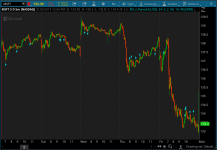Earlier there was mention of Connors RSI(2) Strategy
There are 4 steps to the strategy. Get it Here (Also an excellent resource for Technical Analysis: https://school.stockcharts.com/doku.php?id=trading_strategies:rsi2
There are 4 steps to the strategy. Get it Here (Also an excellent resource for Technical Analysis: https://school.stockcharts.com/doku.php?id=trading_strategies:rsi2
A chart will be coming when I get my fried CPU back from repair.
Code:
# ConnorsRSI Indicator
declare lower;
input Price_RSI_Period = 3;
input Streak_RSI_Period = 2;
input Rank_Lookback = 100;
input OVER_BOUGHT = 90;
input OVER_SOLD = 10;
input SR_LENGTH = 35;
input PRICE = CLOSE;
# Component 1: the RSI of closing price
def priceRSI = reference RSI("price" = PRICE, "length" = Price_RSI_Period);
# Component 2: the RSI of the streak
def upDay = if PRICE > PRICE[1] then 1 else 0;
def downDay = if PRICE < PRICE[1] then -1 else 0;
def upStreak = if upDay != 0 then upStreak[1] + upDay else 0;
def downStreak = if downDay != 0 then downStreak[1] + downDay else 0;
def streak = upStreak + downStreak;
def streakRSI = reference RSI("price" = streak, "length" = Streak_RSI_Period);
# Componenet 3: The percent rank of the current return
def ROC1 = PRICE / PRICE[1] - 1;
def rank = fold i = 1 to Rank_Lookback + 1 with r = 0 do
r + (GetValue(ROC1, i, Rank_Lookback) < ROC1) ;
def pctRank = (rank / Rank_Lookback) * 100 ;
# The final ConnorsRSI calculation, combining the three components
plot ConnorsRSI = round((priceRSI + streakRSI + pctRank) / 3, NUMBEROFDIGITS = 0);
plot SR_HIGH = Round(Highest(ConnorsRSI, LENGTH = SR_LENGTH), NUMBEROFDIGITS = 0);
plot SR_LOW = Round(Lowest(ConnorsRSI, LENGTH = SR_LENGTH), NUMBEROFDIGITS = 0);
ConnorsRSI.AssignValueColor(if ConnorsRSI >= OVER_BOUGHT then Color.Red else if ConnorsRSI <= OVER_SOLD then Color.Green else Color.Gray);
ConnorsRSI.SetLineWeight(3);
SR_HIGH.SetDefaultColor(Color.CYAN);
SR_HIGH.SetLineWeight(1);
SR_LOW.SetDefaultColor(Color.CYAN);
SR_LOW.SetLineWeight(1);
plot OVERBOUGHT = OVER_BOUGHT;
OVERBOUGHT.SetDefaultColor(Color.DARK_GRAY);
OVERBOUGHT.Hide();
OVERBOUGHT.HideBubble();
plot OVERSOLD = OVER_SOLD;
OVERSOLD.SetDefaultColor(Color.DARK_GRAY);
OVERSOLD.Hide();
OVERSOLD.HideBubble();
Last edited:

